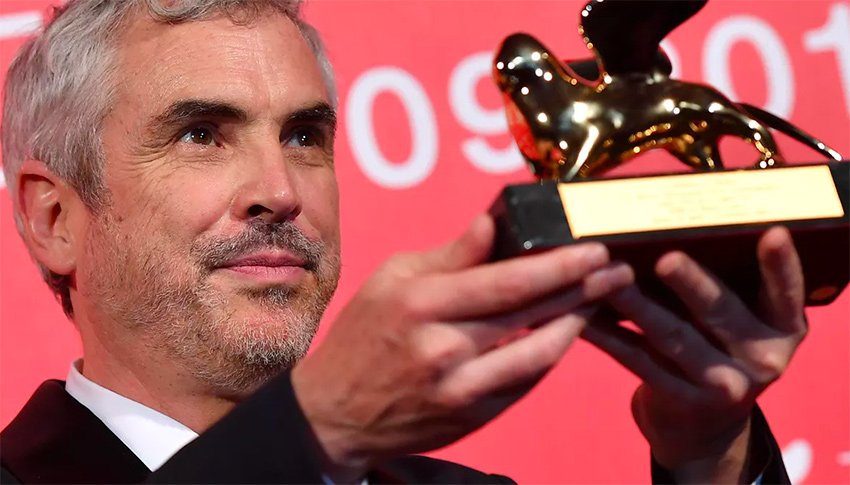Netflix will give broad exposure to a Mexican art film but many other Mexican directors will remain unknown
by Deborah Shaw
Alfonso Cuarón has won the Golden Lion at the 2018 Venice International Film Festival for Roma, his most personal film. The win highlights the importance of Mexican filmmakers in a film culture that is usually dominated by Americans.
Cuarón and his colleagues, Guillermo del Toro and Alejandro González Iñárritu – or the “Three Amigos” as they are known – have become popular fixtures at the Venice festival. Jury president del Toro was the winner of the 2017 Golden Lion for The Shape of Water, while Iñárritu’s Birdman opened the festival in 2014 – an honour shared by Cuarón’s Gravity in 2013.
All three have won Oscars for best director at the Academy Awards – and Cuarón is now a serious contender for best director in 2019 for Roma to follow his award for Gravity in 2014.
Roma is a Mexican Spanish and indigenous language (Mixtec), black and white art film. It is a highly personal project by Cuarón that features the point of view of Cleo (Yalitza Aparicio), a domestic servant working for a middle-class family – a character based on the Cuarón’s family servant, Lobi. It is an intimate film of Cuarón’s youth in the hip Mexico City district of Colonia Roma which blends family history with the social and political Mexico of the early 1970s.
Another newsworthy element of Roma’s success is the way in which the story of the film, and its distribution and exhibition, folds into the developing story of Netflix. That Netflix has chosen Cuarón’s semi-autobiographical drama as the flagship production for its new distribution model reveals much about the streaming company and the way it is challenging existing screen culture.
It tells us that Netflix wants to work with the best directors in the world and that it will support high-quality, non-English language productions that are likely to win prestigious awards. It also tells us that Netflix will support a director-led model for films that avoid big stars and special effects – Roma’s protagonist Cleo is played by Yalitza Aparicio, a non-professional actor who is a teacher in real life.
Netflix offers an alternative to traditional models that restrict these art films to a limited festival run and restricted theatrical release with low box-office takings.
Netflix has used Roma to break a deadlock with festivals seen in Netflix’s previous refusal to agree to a theatrical release, and Cannes film festival’s resulting refusal to allow Roma and other Netflix productions to enter into competition if they aren’t slated for theatrical distribution in France. The new Netflix model introduced by Roma enters films in festival competition and agrees to limited theatrical distribution, but also bypasses lengthy delays between cinema and streaming release.
Following Venice, Roma is playing in competition at Telluride, Toronto, London, New York and Copenhagen. It will be followed by an (as yet unspecified) limited theatrical release, and a global release on the streaming site, scheduled for December 1, 2018. Cuarón has highlighted this as a principal attraction of working with Netflix.
Working as his own cinematographer as a result of the lack of availability of his longtime collaborator Emmanuel Lubezki, Cuarón made a film to be seen on the big screen. It has state-of-the-art sound design and was shot on 65mm using the Alexa65 digital camera. This resulted in a “really pristine, almost never-before-seen black and white”, according to David Linde, the film’s producer. But the filmmakers also wanted the film to be seen by a global audience, an ambition that can be realized by its release on the biggest streaming platform in the world.
The high level of backing for a Mexican art film may appear to be a risky move for Netflix, but it follows its approach of support for a certain type of auteurist filmmaker, those who have a track record of excellence and are embraced by both festival and global audiences. These are directors who can be trusted to create high-quality films or series (examples include the Coen brothers, Paul Greengrass, Martin Scorsese, Steven Soderbergh, and Lana and Lily Wachowski).
While Netflix has been celebrated for investing in new and exciting voices and embracing diversity, directors have to jump through many hoops to be rewarded with such a high-profile distribution and exhibition platform.
As a multi award-winning director, Cuarón belongs to a Netflix executive class of director. Cuarón had to achieve stratospheric brilliance with his award-winning Gravity to be given such first-class treatment for a film set in Mexico City. That he has been able to make his most personal film yet is due entirely to his profile and status secured largely in filmmaking outside of his home country (with the exception of his low-budget Y Tu Mamá También). Cuarón has, to his credit, used his privilege to make a Mexican film that has a focus on the sort of working-class character that is severely underrepresented in mainstream cinema.
There is a rich cinematic culture in Mexico – and there are a number of directors deserving of wider international acclaim. These include: Fernando Eimbcke, Amat Escalante, Michel Franco, Maya Goded, Tatiana Huezo, Issa López, María Novaro, Alonso Ruizpalacios, Juan Carlos Rulfo and Carlos Reygadas.
There is much to celebrate in Netflix’s new film production, exhibition and distribution model – and in Roma’s success, particularly in the wider distribution it offers to filmmakers and increased access to films for its subscribers. Nonetheless, this model is still reserved for filmmaking royalty, and the festival, theatrical release and streaming platforms afforded Roma is an exception.
Most high-quality non-English language films will, unfortunately, remain unseen by large audiences.
(Deborah Shaw is a reader in film studies at the University of Portsmouth. This article is republished from The Conversation under a Creative Commons license).



